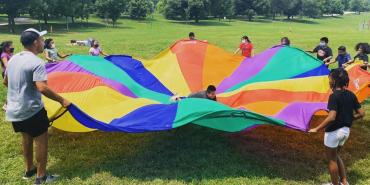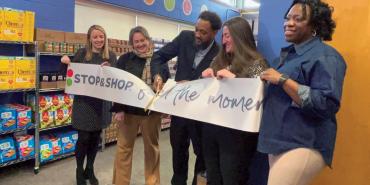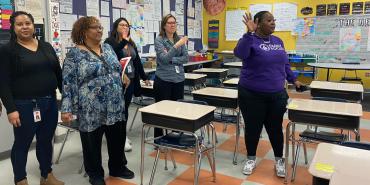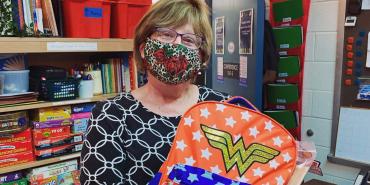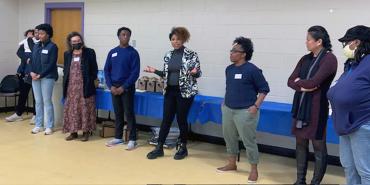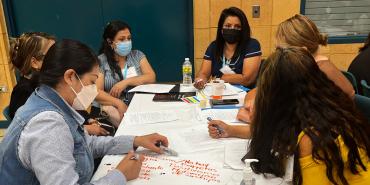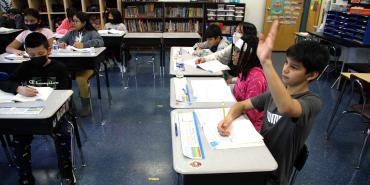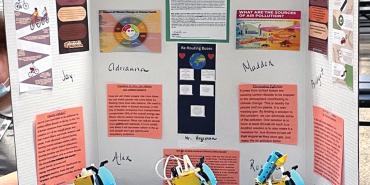Community schools are a powerful strategy for increasing educational equity, reducing barriers to learning, and helping students succeed academically. That’s one reason that the AFT is working to increase the number of community schools we support from 700 to 2,500 by 2027.*
The work of creating a community school, though richly rewarding, is not without challenges, both in building the stakeholder coalitions necessary to implement community schools, and in securing the wide support to maintain them for long-term success. Here, three union leaders and activists describe their journeys, the challenges they’ve encountered along the way, and their hopes for the future:
- Jessica Tang is the president of the Boston Teachers Union and a vice president of the AFT and the Massachusetts AFL-CIO. Previously, she taught middle school social studies in Boston.
- Jennifer “Jen” Johnson, former chief of staff of the Chicago Teachers Union, taught high school history for 10 years in Chicago. She recently became the deputy mayor of education, youth, and human services for the city of Chicago.
- Katrina Kickbush teaches special education at Wolfe Street Academy in Baltimore and is the building representative for the Baltimore Teachers Union.
As their comments reveal, it’s true that community schools are hubs where teachers, families, community members, and service providers can come together in purposeful, results-focused ways. It’s also true that going to a school where you can also get eyeglasses and take home a bag of groceries can be life changing. But still, the services are not the key. The real secret to community schools’ success is the relationships that are nurtured through the process of identifying needs, strengths, and partners.
While integrated student supports, or wraparound services, get a lot of attention, they are only one part of the community school strategy. Community schools are also focused on deep family and community engagement along with collaborative leadership practices. These pieces of the puzzle are often what set community schools apart as an effective whole-school improvement strategy because they are essential for bringing in strategic partnerships and often pave the way for more deliberate integration between what happens inside and outside the classroom. They are also essential for developing meaningful relationships, which lead to identifying community assets and creating the environment and networks needed for sustainability.
In a world where people feel divided and isolated, community schools are welcoming spaces for people to connect. They are safe places for students and families to find their voices as valued members and leaders of their school community. And, as this Q&A shows, community schools are unifying people and helping them rethink the promise and purpose of public schools.
–EDITORS
EDITORS: Tell us about your community schools journey.
JESSICA TANG: We began advocating for more “community hub schools,” as we call them in Boston, 10 years ago. The Chicago Teachers Union (CTU) strike in 2012 was one of the formative moments for me on this journey. I was still in the classroom then, and it was an inspiration to see the CTU fighting for what students need. Their message, “creating the schools our students deserve,” really resonated with me, and I knew that we as a union needed to be clearer about what we are for, not just what we are against.
I’d learned about community schools through the AFT and other locals, and I was interested in figuring out how we could fight for more community schools here in Boston. Previously, while I was an executive board member, I also helped to found the Boston Education Justice Alliance (BEJA), a coalition of students, educators, families, school staff, and community members fighting together for public education. When I shared what I had learned about community schools, this also became a priority for BEJA. I left the classroom in 2013 and became the founding organizing director of the Boston Teachers Union (BTU) and prioritized this work in that role. The BTU partnered with BEJA, the Greater Boston YMCA, allies in Boston Public Schools (BPS), and other key groups on a campaign to expand community schools in BPS.
It was a long and slow road. Community schools aren’t new to Boston, but many people didn’t understand them. Some people conflated community schools with neighborhood schools (a very divisive topic because of Boston’s history of busing and school segregation). And some schools that were originally established as community schools had lost that focus and framework over the years. So, we started by sharing what community schools are through community forums and professional development for district staff. We also changed the name to Boston Community Hub Schools to lessen confusion.
It wasn’t until 2019 that we successfully negotiated in our contract a hub schools coordinator for BPS to help spearhead district implementation. We’d been able to establish three community schools through grants, and we needed to ensure that they’d be sustainable long after the funding ran out, so that was also included in our contract. This all helped pave the way for a citywide expansion and pilot of 11 additional community hub schools beginning in 2022.
Six of our 14 schools have school coordinator positions that are staffed by the YMCA, and seven have BTU hub school coordinator positions. (One school lost its BTU coordinator, and we agreed to fill that position for the 2023–24 school year.) We also now have a director of community schools and another central office staff person working in close partnership and collaboration with the YMCA. In our most recent contract, we also established language to continue to negotiate an expansion of hub community schools.
While we still have outstanding negotiations on the topic of hub schools, we work very closely and collaboratively with BPS and the YMCA, and we are now also partnering with the United Way to continue this work. In addition, our mayor, Michelle Wu, her senior advisor for youth and schools, and our new superintendent are all supporting this effort. We still have a lot of work ahead, but we’re poised to do good work here in Boston. We will continue to support a cohort of 14 schools in fall 2023, and we’re working to ensure that we’re well coordinated and implementing our community hub schools framework with fidelity.
JENNIFER JOHNSON: I appreciate that the 2012 CTU strike inspired Jessica—it was our first in 25 years. In the last decade, the CTU has continued fighting for the schools Chicago students deserve. Our members are not only union members or educators; many are parents and community leaders as well. So we believe in working with our community partners, and we’ve placed a high value on relationships with longstanding grassroots community groups that are serving the underserved communities of Chicago. For several years, we’d been in constant dialogue with a community coalition called the Grassroots Education Movement, and the topic of community schools began to come up in those conversations.
Our community coalition had put a lot of thought into how to transform public schools into the schools that our students deserve. Community schools have been in Chicago for a very long time, and they do great work. But we are under-engaging our parents and students. We learned from our community partners that we can build on our history of community schooling and implement the model in a transformative way.
There are several different framings of the community school model—some have four pillars, others have five, and there’s a lot of overlap in them. We use the six community school pillars from the Center for Popular Democracy report: engaging, challenging, culturally relevant curricula; emphasis on high-quality teaching (not high-stakes testing); wraparound supports; positive discipline practices such as restorative justice and social-emotional learning; authentic parent and community engagement; and inclusive school leadership.†
To us, the most important pillar is inclusive school leadership. We believe schooling should be a bottom-up endeavor, where the leaders and decision makers are those stakeholders who are served by the school and incorporate the wisdom of the community into all aspects of the school. That goal is supported by the seven principles that we co-developed with our community partners (and ultimately, the district agreed) to undergird the pillars: racial justice and equity; transparency and trusting relationships; self-determination and governance; build from community strengths, community wisdom, and data/best practice/evidence; shared leadership and collaboration; reflective learning culture; and a whole-child approach to education. The pillars outline what you should see and experience in a sustainable community school, but the principles describe how those pillars should be enacted.
In our 2016 contract fight with the district, we brought a community school proposal to the table. The proposal really originated among our community partners, who had a huge vision: a 75-year plan to build a sustainable community school district throughout Chicago. We held a one-day strike on April 1, 2016, and just over six months later, settled a contract that won $10 million to implement 20 sustainable community schools.‡
Our goal was to focus on schools that are not the most well-resourced in our city and district. We wanted to establish feeder patterns so that students could go from sustainable community elementary schools all the way to sustainable community high schools. We wanted our schools to be geographically dispersed around the city. Finally, we wanted a diversity of service partners—not just the citywide community organizations. We very much wanted to make sure that those grassroots community partners who were part of coming up with this idea would be part of its implementation.
We went through the district’s scoring and selection process, which we tried to make as nuanced as possible, and then debated with them to land on our final 20 schools and our community partners. The selected partners submitted interest letters to the schools they wanted to work with, and school principals then chose who would partner with their schools. We tried to do it all as collaboratively as we could. Finally, in the 2017–18 school year, we launched our 20 sustainable community schools, which we’re very proud of.
KATRINA KICKBUSH: My journey was a little different. I joined Wolfe Street Academy§ about four years after it had become a community school. Wolfe is part of Baltimore City Public Schools and is operated by the Baltimore Curriculum Project. We became a community school in 2006, essentially in response to a school need.
Shortly after our principal, Mark Gaither, began at Wolfe, someone approached him about becoming a community school. He was hesitant at first. It seemed like one more in a long line of things to oversee, and he had bigger priorities: Wolfe was struggling, and he needed to get it turned around. The person who approached him, the community school site coordinator, offered to help him focus on our biggest problem, which at the time was chronic absences. And so they worked on attendance for most of that first year. Our school staff made a lot of phone calls and home visits, but our approach was community-centered and supportive, not punitive or accusatory. Rather than asking families, “Why aren’t your children in school?,” we’d say, “It’s so important that we see your students in school. What barriers are making it difficult to get them here, and how can we work on a solution together?”
Some students couldn’t get here on time because of family work schedules. Some parents kept their children out of school altogether because they thought students would be punished for tardiness. We listened. Then we asked, “How can we help?” Did families need alarm clocks? A wake-up call? An arranged ride? We told one family, “We just want to see your child; we don’t care what time you get here. School starts at 7:45, but if you get home from work at 9 a.m., bring them in at 9 a.m.”
We also implemented a “walking school bus,” where a local parent (who was also our lunch cafeteria monitor) would walk to the homes of these families every morning, collect their students, and walk with them to school. We began incentives like giveaways, attendance competitions, and awards to allow whole classes to celebrate the importance of being at school.
Attendance over that first year improved so dramatically that Mr. Gaither was convinced. He began advocating for Wolfe to become a community school. And after a couple of years focusing on getting students and families into the building—making connections and relationships with families in the process—we began adding services to meet other needs. Based on what we heard from families, we partnered with local organizations for dental, vision, and other services, always focusing closely on one before adding another, and always listening to our community to determine the next step.
Five or six years into our journey, I had the opportunity to explain to others in a stakeholders meeting how this strategy was impacting our school. Because we now had systems in place to meet our students’ needs, they came to class ready to learn and teachers could focus on teaching. That was the beginning of a larger discussion about bringing more community schools to Maryland. Strong Schools Maryland, a grassroots organization fighting for public education, began advocating for legislation of a new funding model so that every school could open as a community school or with a community school site coordinator. Like Jessica did in Boston, we started working with our community to build support, meeting with parents and providing education about community schools. We rented a bus and brought families with us to talk to our state legislators about community schools. Because most of our community speaks Spanish, we also brought interpreters so that all families had a voice in the process. And we continue to work together to get policies that give our children what they need moving forward.
EDITORS: What challenges did you encounter, and how did you overcome them?
JESSICA: This work is not easy, and we’ve learned so much not only from the last 10 years of getting these schools started, but also just from our pilot year. One of our greatest challenges was having leaders who weren’t knowledgeable about community hub schools, didn’t really seem to believe in them, or had very different ideas about which schools should be community hub schools. That’s what happened with a former assistant superintendent when we were in the process of selecting the schools for our first cohort.
This person had never taught or worked in a school, and truthfully, we butted heads with her when she chose dual language schools for our first cohort. Dual language schools already have a lot going on, so transitioning to community schools would be especially difficult. We had trouble in our pilot year because the principals of these schools didn’t really understand the community hub schools strategy or the role of the site coordinator. I think they agreed to participate because it meant getting an extra staff position, but they didn’t have a full understanding of what a community hub school is.
Leadership turnover in the city and Boston Public Schools has also been a huge challenge. In the last 10 years, we’ve had no less than six superintendents and three school committee chairs. On the city leadership side, we’ve had four mayors and a few education chiefs and health and human services chiefs. This lack of stability has been frustrating. It seemed every time we made some progress, there’d be a leadership change and we’d have to start all over, explaining what community hub schools are and why they’re important. For this work to get traction, you need district and city leaders with experience who will champion community schools. Having partners in the central office doesn’t necessarily mean that will happen. You need people with decision-making authority in place. Ideally, anchor positions for the community hub schools would be jointly funded by the district and union and codified into our contract so that we have leverage from the inside to elevate the work.
One of our internal challenges was role confusion. There are so many different roles necessary to make community hub schools function with integrity—including the hub schools coordinator, family liaisons, community field coordinators, social workers, operations leaders, school leaders, and student support teams. In some schools, not everyone understood their roles, what they were responsible for, or how the roles work together. This led to people feeling threatened or territorial about their role, which is not the collaborative team culture we’re cultivating. So we’re trying to work that out at the contract level by negotiating job descriptions and at the site level by providing professional development based on each school’s needs.
Currently, our city and district leaders are fully supportive of this work, and our district is really trying to stabilize. Our mayor has three years left in her term, our new superintendent is fully committed, and the school committee chair was recently reelected. So we are finally all on the same page and hopeful that we have a period of progress ahead. But with our history of leadership turnover, we feel some urgency to get things in place while we have this support so that our community hub schools are functioning well long-term. For our next contract, we are working to codify the number of schools we have, all job descriptions, and joint district-union roles for the citywide coordinator and director positions.
JENNIFER: District support is so critical to moving this work forward. Our battles for the first year and a half were also about getting on the same page with the school district. For us, it was critical to help them see that they were obligated to enact this partnership and to influence the implementation to make it more transformational.
One of our biggest challenges has been the district bureaucracy we’ve encountered in getting our community-based partners to the table. We know that certain district rules are well-intentioned to protect against legal liability and conflicts of interest. But some processes just don’t align with the principle of building community schools on community wisdom. The district didn’t want our community-based partners to help implement community schools because they’d receive funds through the schools. And of course, we need to operate ethically; community schools are not a slush fund. But this is about doing real work, and the community-based partners who do that work need to be given a voice and space at the table. They need to be treated like assets rather than potential liabilities.
We fought to have all of our partners included in the initial round of implementation, but the district leadership was particularly intransigent at that time. To move forward, we had to reset our negotiating team and bring in new partners who were connected to our community-based organizations and to our schools, but who wouldn’t ever receive funding.
We’ve lost some of the community partners who were part of this vision from the beginning, largely because of the bureaucracy. There’s so much red tape that our partners have to get through to receive funds, to pay their staff, and to even be inside the school buildings. If their organizations are not large enough to allow them to manage things like data entry or tech support, it can be an overwhelming barrier. The district’s reimbursement model also creates tremendous cash flow problems for smaller organizations—they have to render services and use their own funds when necessary and then wait for weeks to be reimbursed. We need these partnerships to be sustainable long-term, but the bureaucracy does not align with our goal of building long-term relationships in which partners are deeply invested. We have better relationships now with district leaders and some of this has improved, but it’s still a challenge for grassroots partners. Fortunately, many of our stalwart grassroots organizations are still with us.
The district also wanted some citywide service agencies brought in because they have popular, engaging services and schools are more familiar with them. And we want students to get those programs and services. But we don’t think community schools should just be about programs and services. Ultimately, we want to create space for collective advocacy to achieve systemic change aligned to our seven principles. But larger agencies don’t necessarily have the same justice-centered, transformational, movement-building mindset as our grassroots organizations. They want to meet needs but not necessarily challenge systems. What citywide agencies do have is cash flow and the ability to expand quickly and manage the bureaucracy, so they are favored by these district processes. Other wonderful organizations that are already doing transformational work centered on healing and restorative justice can’t meet the bureaucratic requirements. It’s just wrong that we’re not set up to support the transformational organizations that are deeply rooted and do the nitty-gritty community work.
We’re really interested in figuring out how the district can meet its ethical and legal obligations while also adding flexibility to its processes to allow more of our community members who are the most deeply connected to do this work. There’s no single solution, and I can see lots of different models working better than what we have now. Even something as simple as eliminating the arbitrary fee the district charges to expedite an organization’s reimbursement would make a significant difference. Ultimately, it’s about the district showing that it values our partners as an integral part of our community and working with them to make our schools better.
KATRINA: My school is a well-established community school, so we no longer have the start-up strain that Jessica and Jennifer have experienced, but we still have challenges. Ours are more related to sustainability, as Jennifer mentioned. We’re always asking how we can continue to grow and meet more of our community’s needs.
Our building and infrastructure are a challenge. When I started at Wolfe 13 years ago, we had one class at every grade level. We’ve now doubled that, but our building is not equipped for it. We don’t have a gymnasium or the space for so many things we want to do. We also really wish we could be a P–8 school. We feel that we could really help shape our kids’ future if we could keep them through middle school and prepare them for high schools that will move them forward in their education.
But we need resources to develop solutions to these challenges, which introduces another challenge: our resource pool can’t keep up with the growth of community schools in Baltimore. Baltimore City Public Schools went from 17 community schools when I started to 125 now—and more are being added. The same handful of community partners is serving all of us, and we need to consider how that impacts the sustainability of our model.
Our food bank partner is doing its best to keep up with the demands of our community schools with its monthly food giveaways. These giveaways feed about 100 people in our school community, and sometimes the need is greater and there are more people standing in line waiting. Every time we place our order, it is more challenging to find the items our community needs. Many times, what’s available are things our families have told us they aren’t comfortable eating. How do we get more of those foods they need prioritized—and how do schools with similar populations do the same—when that resource is being continually spread out over more schools?
Our dental program is now serving so many other schools that it’s hard to get Wolfe students on the calendar. The Vision Van of Baltimore, which used to come every year, now only comes every three years. The district is pushing for more Baltimore community schools, and rather than asking our partners to provide services to more schools, we need to tap into more resource partners in Maryland. We have tried to research additional resource partners on our own, and it’s very challenging. This year, the district has a new partnership and volunteer office that plans to begin looking for additional partnerships. I’m hopeful that this office will be able to support us—and all of our community schools—in managing and developing partnerships so that we will no longer be fending for ourselves to find additional resources.
And another issue is what Jennifer already mentioned: the district bureaucracy governing becoming a community resource partner. The approvals process can get very complicated, and then once approved, the strings attached to the money are what really guide or even determine the program instead of being able to use the money to guide the program that our students need.
EDITORS: Speaking of what students need, how do you approach the common misconception that community schools are just coordinating partners for wraparound services?
KATRINA: Obviously, wraparound services are an important component, but that’s not really the heart of what a community school is. A well-functioning community school is intentional and strategic about what services are offered, based on the needs of the community. And it’s about looking to the community to identify those needs and to be at the table in deciding how to meet them.
JESSICA: Exactly. Sometimes we see schools and principals wanting whatever resources they can get, so they partner with dozens of different organizations—but there’s no way of determining whether these programs are meeting the actual needs of the community. They’re not asking, “Is this program helping to amplify our strategic or academic priorities? Is it giving voice to our families who really need to be heard?” That alignment is critical.
You could have a great afterschool program for technology, like Laptops 4 Learning, which gives laptops to families. But if 80 percent of the families in your community are actually looking for English as a second language classes, the laptop program won’t be as effective as it could be—because you didn’t ask them what they wanted. In the same way, you can bring in an urban gardening program that’s not as richly engaging as it would be if you had included families who have expertise in gardening. Strategic partnerships—and great family engagement opportunities—come from intentionally assessing both the needs and strengths of the community.
KATRINA: Building on the community’s assets to address needs is key. All our teachers and school staff know this, so when we talk with families, we’re constantly asking both “What do you need?” and “What is your strength? What can you help us with in our community?”
Families feel so much more valued and invested when they know that we are going beyond providing solutions for problems in their lives to really engaging them in working toward those solutions. So, we focus on authentic family engagement at Wolfe Street. It may start through a service, but as we build trust and relationships, families see us as partners in education and in making things better for all of us. That’s why parents stood with us to advocate for legislation that strengthens public education. And that’s why we have high family participation in our parent-teacher conferences, back-to-school nights, and other school activities. Parents want to be involved here. Some end up working at Wolfe or sharing their skills and assets here, such as using language skills to translate for families or catering a school event with a family-owned restaurant. And through that engagement, those relationships, and that trust, our school community grows, our staff grows, and our ability to collectively meet our community’s needs while building on our community’s strengths is greater.
JENNIFER: The shared leadership of the community is at the core of transformational community schools. It’s not just about services. It’s about creating school communities of stakeholders who are advocating collectively for themselves. Part of that is ensuring educators are empowered and supported to create and implement curriculum that is racially just and engaging. This in turn allows students to find their own agency and understand the systemic challenges we all face. It’s not rocket science that students feel more connected and have better academic outcomes when they have engaging curriculum and their basic needs are met. And at the CTU, we’re going to continue to fight for every school to have those basics: school nurses, dental services, librarians, food pantries, clothes closets, and more. But it’s beyond that. It’s about a true spirit of shared, inclusive leadership where stakeholders see that “Oh wow, look at all that our school can achieve—and I can be a part of it. I can be a leader and fight for the things we still don’t have, even with additional services and resources.”
That’s why we have guiding principles in this work. Everything we do is from the belief that school communities deserve to have self-determination, and they have wisdom and knowledge to be built on.
KATRINA: Those guiding principles affect everything we do: how we teach, how we problem-solve with our communities, even how we approach student behavioral issues. We don’t believe in suspension at Wolfe Street Academy. We use mindfulness strategies and restorative circles, as well as knowing families well enough to understand what’s happening in each child’s life. While some behaviors do require more serious consequences, we strive to not suspend kids unless we’re legally required to. Our philosophy is inclusion, community rebuilding, community talking together. Students thrive in that environment, and it’s easier to teach in a school with these systems and supports in place. Wolfe is my first community school, and after this experience, I wouldn’t want to teach anywhere that wasn’t a community school.
EDITORS: Looking back over your journey, what are you proud of, and what’s next?
JENNIFER: One of our biggest successes is the extensive professional development we’ve provided for our schools over the last five years. We prioritize an annual summer institute for the administrators, teachers, staff, students, and parents of all of our 20 schools to gather and learn from each other about important topics. We also try to do a full day of professional development each quarter, largely centering anti-racism through restorative justice practices or curriculum. It’s been incredibly important for building relationships and shifting mindsets in our very segregated city to make sure that our students—who are largely young people of color—have their experiences and history centered. Our last PD focused on Black-Brown solidarity, which has historically been a challenge in Chicago and can be challenging in some of our sustainable community schools today.
We’re also really proud of our curriculum circles, where teachers, students, and community partners co-create curriculum on culturally relevant and engaging topics, which aligns with our first pillar of community schools. A small group of our CTU member teachers came together with our organizer and, with support from an AFT innovation grant, co-created a Black Panther curriculum with some of our schools and communities. The idea came about collaboratively, as our community partners shared that part of the vision for sustainable community schools was rooted in Chicago’s history of community-based struggle. Teachers and students visited the West Side Community Justice Center, met current Black Panther Party leaders, and worked together to tweak and pilot a curriculum that demystifies organizing and stereotypes around the Black Panthers. We shared our curriculum circles through two Share My Lesson webinars—one on the Black Panther curriculum,** and the other on the process of co-developing curriculum with students and community partners.††
There are lots of things we want to do next. We want to keep improving on our inclusive school leadership. In Chicago Public Schools, there can be a real deference to principal autonomy. If you have a thoughtful principal who’s aligned with the community schools pillars and who engages with stakeholders without seeing that as a threat to their power, it’s wonderful. But too often, school leaders are rewarded for being tightly in control. So we’re still on a journey of building champion administrators who share power and decision-making and have a different mindset about how school leadership can look.
We are in conversations about adding more community school positions that are co-staffed between the union and school district, and we want to make the community schools evaluation process much more transformational through participatory research led by members of our school communities. Eventually, we also want to win more community schools. But meanwhile, we are still working on building trust with the district, which hasn’t always seen us as a valued partner. In some ways, we’ve really turned a corner, and we’ve got a lot more credibility as a union than we had 10 years ago. We’ve shown that we’re not fighting just to fight—we’re fighting for what kids and communities need. But when you bring us to the table, we don’t just fight: we work, we collaborate, and we’re capable of compromise. We’re not audacious to the point of impracticality. So we’re in a much better place now.
And we’re looking forward to elevating sustainable community schools through our elected leaders and organizing more people to understand this as a priority. In April, CTU member, Cook County Commissioner, and former middle school teacher Brandon Johnson won the tight Chicago mayoral race. He supports public education and the sustainable community schools model, so we’re confident that we’re moving into a phase where this work will be respected and built on. We still have work to do to remove barriers to expansion, like increasing funding for all our schools and supporting our community partners to have greater capacity to work with our schools. But we’re in a place of lots of possibility and hope. We just have to keep fighting and winning.
KATRINA: I’m really proud of the trust and relationships we’ve been able to sustain with parents and families. Those relationships are what get parents to engage deeply in their students’ learning. We have near-100 percent attendance at special education meetings. We host curriculum nights because our migrant and bilingual families said they wanted to learn our curriculum better so they could more deeply engage with their children. Now we have a curriculum night every month, and we have 50 to 60 parents come each night to learn how they can support their children in science, reading, math, and other learning. Once a month we also have an ESOL (English for speakers of other languages) parent meeting, and we again get about 50 parents attending—that’s significant.
We’ve built these relationships by listening to families’ needs and working together on solutions and supports to meet those needs. And we want to keep growing in our ability to do that. Our families are telling us they want support with filling out applications for public library cards. They want support with landlords and landlord laws in Baltimore. More families need support with the Fair Connectivity Act to be able to get access to the internet. And this year especially, we’ve seen parents pushing for ESOL classes; they want to become more proficient in English so they can better advocate for themselves and their families.
In the spring, we worked with our community center to find teachers for these ESOL classes. We were hoping to start offering them in late 2022, but our partner withdrew. It was a disappointing setback, but our leadership team quickly regrouped to figure out how we could make it happen—and ESOL classes began in late March.
We also hear from our parents that they want parenting classes. Our community school site coordinator and our mental health professional led some parenting classes, but our families want more. So, we are looking at our next steps, determining how we can bring in other partners or resources, like the Chicago Parenting Program, to help address this need.
JESSICA: I’m proud of so many things about our journey. It’s taken 10 years, but we’re still here, we’re finally in a great place with our leadership and partnerships, and I think we feel more hopeful than we have in a long time that we’re going to get this right. I’m proud of the fact that we’ve made anti-racism and racial justice a huge focus of our community school work. Anti-racism isn’t typically the centerpiece of a community hub schools model, but it’s so important to the Boston Teachers Union that we passed a resolution in 2019 specifically calling for our union to lead in anti-racism work.
We know how damaging structural and institutional racism can be and has been for the students we serve, so we are trying to lead the effort to fight it intentionally. How can we have a model for school improvement that doesn’t also thoughtfully include the anti-racism perspective and how it contributes to racial equity? We are trying to amplify the power of our students, families, and educators so that they can drive bottom-up rather than top-down solutions. So approaching this work with a racial justice framework is important.
Looking forward, our goal is to eventually have all Boston schools be community hub schools. We have a lot of work ahead if we’re going to accomplish that. Ideally, we’d revisit the process of identifying and selecting prospective schools so it’s more intentional and leads to schools with real interest in and knowledge about community schools. We also want to get some key things like roles and job descriptions codified in our next contract so we are able to expand the model to more schools and expand our leadership group to the larger community. And we want to negotiate new language for our community hub schools coordinator positions that doesn’t attach a set amount of money to the position (a lesson we learned from observing other districts). But we need to start with ensuring all our school stakeholders really understand the framework and what it means to be a community hub school.
EDITORS: What advice would you give those who are just starting this journey or thinking about creating community schools in their areas?
JESSICA: Know that this work takes time and requires a groundswell of community support and coalition work—and truthfully, that work is not easy. But it’s OK to start slowly and small, with just a few really committed people who don’t give up. The core group of us pushing for community schools in Boston have been working together for 10 years now. We’ve been through so many challenges together. We’ve had to be flexible. We’ve had to start over. We’ve had to be patient. But we didn’t give up.
JENNIFER: Definitely don’t give up. This really is a journey, and it doesn’t happen overnight. Also, be prepared to spend a lot of time winning folks over and fighting for what you know your students deserve. Even though there’s so much research and history supporting the value and impact of community schools, there are some ingrained traditional systems and perspectives that you’ll need to push against to win a community school that’s truly transformational and sustainable. And things won’t always go like you planned, so you need to be resilient and persistent and keep trying. Keep fighting.
KATRINA: What I’ll add is that you need persistence even if you’re an established community school. Even 17 years in, we are still struggling to get certain services off the ground. And that’s why I think it’s important to start small, as Jessica said. Pick one thing and do it well; otherwise, you’ll lose the trust of your staff, students, families, and the community partners that are supporting you.
The community school strategy has made a huge difference for the students at Wolfe Street Academy. It’s changed how and what we teach, and it’s changed our community for the better. I think everyone needs to be talking about community schools with their union representatives, students, families, and community members. People really need to understand why and how this strategy makes a difference in children’s lives.
*For the AFT’s community schools resources, see go.aft.org/g75. (return to article)
†To learn more, read the Center for Popular Democracy report at go.aft.org/yke. (return to article)
‡To learn more about CTU’s fight for sustainable community schools in Chicago, visit go.aft.org/yzh. (return to article)
§To learn more about Wolfe Street Academy, watch “How a Community School Helps ELLs Succeed” by Colorín Colorado and the AFT: go.aft.org/5lw. (return to article)
**To learn more about the Black Panther Party curriculum, watch the Share My Lesson webinar at go.aft.org/c0y. (return to article)
††To learn why co-developed anti-racist curriculum is central to Chicago’s sustainable community schools initiative, watch the Share My Lesson webinar at go.aft.org/cov. (return to article)
[Photos: courtesy of the Boston Teachers Union, Chicago Teachers Union, and Baltimore Teachers Union]

